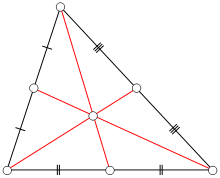Median (geometry)

In geometry, a median of a triangle is a line segment joining a vertex to the midpoint of the opposing side. Every triangle has exactly three medians, one from each vertex, and they all intersect each other at the triangle's centroid. In the case of isosceles and equilateral triangles, a median bisects any angle at a vertex whose two adjacent sides are equal in length.
The concept of a median extends to tetrahedra.
Relation to center of mass
Each median of a triangle passes through the triangle's centroid, which is the center of mass of an infinitely thin object of uniform density coinciding with the triangle.[1] Thus the object would balance on the intersection point of the medians. The centroid is twice as close along any median to the side that the median intersects as it is to the vertex it emanates from.
Equal-area division

Each median divides the area of the triangle in half; hence the name, and hence a triangular object of uniform density would balance on any median. (Any other lines which divide the area of the triangle into two equal parts do not pass through the centroid.)[2][3] The three medians divide the triangle into six smaller triangles of equal area.
Proof of equal-area property
Consider a triangle ABC. Let D be the midpoint of , E be the midpoint of , F be the midpoint of , and O be the centroid (most commonly denoted G).
By definition, . Thus and , where represents the area of triangle ; these hold because in each case the two triangles have bases of equal length and share a common altitude from the (extended) base, and a triangle's area equals one-half its base times its height.
We have:
Thus, and
Since , therefore, . Using the same method, one can show that .
Three congruent triangles
In 2014 Lee Sallows discovered the following theorem:[4]
- The medians of any triangle dissect it into six equal area smaller triangles as in the figure above where three adjacent pairs of triangles meet at the midpoints D, E and F. If the two triangles in each such pair are rotated about their common midpoint until they meet so as to share a common side, then the three new triangles formed by the union of each pair are congruent.
Formulas involving the medians' lengths
The lengths of the medians can be obtained from Apollonius' theorem as:
where a, b and c are the sides of the triangle with respective medians ma, mb, and mc from their midpoints.
Thus we have the relationships:[5]
Other properties
The centroid divides each median into parts in the ratio 2:1, with the centroid being twice as close to the midpoint of a side as it is to the opposite vertex.
For any triangle with sides and medians [6]
and
The medians from sides of lengths a and b are perpendicular if and only if [7]
The medians of a right triangle with hypotenuse c satisfy
Any triangle's area T can be expressed in terms of its medians , and as follows. Denoting their semi-sum (ma + mb + mc)/2 as σ, we have[8]
Tetrahedron
A tetrahedron is a three-dimensional object having four triangular faces. A line segment joining a vertex of a tetrahedron with the centroid of the opposite face is called a median of the tetrahedron. There are four medians, and they are all concurrent at the centroid of the tetrahedron.[9] As in the two-dimensional case, the centroid of the tetrahedron is the center of mass.
See also
References
- ↑ Weisstein, Eric W. (2010). CRC Concise Encyclopedia of Mathematics, Second Edition. CRC Press. pp. 375–377. ISBN 9781420035223.
- ↑ Bottomley, Henry. "Medians and Area Bisectors of a Triangle". Retrieved 27 September 2013.
- ↑ Dunn, J. A., and Pretty, J. E., "Halving a triangle," Mathematical Gazette 56, May 1972, 105-108.
- ↑ Sallows, Lee, "A Triangle Theorem" Mathematics Magazine, Vol. 87, No. 5 (December 2014), p. 381
- ↑ Déplanche, Y. (1996). Diccio fórmulas. Medianas de un triángulo. Edunsa. p. 22. ISBN 978-84-7747-119-6. Retrieved 2011-04-24.
- ↑ Posamentier, Alfred S., and Salkind, Charles T., Challenging Problems in Geometry, Dover, 1996: pp. 86–87.
- ↑ Boskoff, Homentcovschi, and Suceava (2009), Mathematical Gazette, Note 93.15.
- ↑ Benyi, Arpad, "A Heron-type formula for the triangle", Mathematical Gazette 87, July 2003, 324–326.
- ↑ Leung, Kam-tim; and Suen, Suk-nam; "Vectors, matrices and geometry", Hong Kong University Press, 1994, pp. 53–54
External links
| Wikimedia Commons has media related to Median (geometry). |
- The Medians at cut-the-knot
- Area of Median Triangle at cut-the-knot
- Medians of a triangle With interactive animation
- Constructing a median of a triangle with compass and straightedge animated demonstration
- Weisstein, Eric W. "Triangle Median". MathWorld.